by Jill & Sarah | Oct 14, 2017 | In The Loop
Literatura
This week we focused on grammar and writing. Our objectives were:
- understand how to vary sentences and stay on topic within writing
- continue working on Halloween autobiography
- building a better understanding of what auxiliary verbs are by creating verb trees
- understand what topic sentences are and be able to identify the topic
- understand and be able to identify different types of sentences
Matemáticas
This week we completed Chapter 3 Addition up to 10,000. Our objectives were:
- Review 4 digit addition with and without regrouping.
- Add greater numbers with regrouping in ones, tens, and hundreds
Remember that students should complete 50 minutes of Khan Academy each week!
History & Geography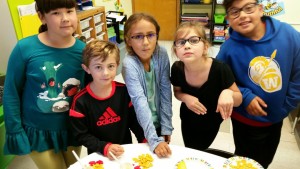
We wrapped up our World Rivers unit this week. We discussed trade on rivers, worked on river research, took our unit assessment, and celebrated the end of our unit by wearing blue and sampling some “river” related food.
Our objectives were to:
• explain how Rivers help people trade with each other
• refer to a map and describe the locations of the Rhine, Danube, Volga, and Niger Rivers
• understand the meaning of the following domain-specific vocabulary: toll, manufactured good, network, and canal
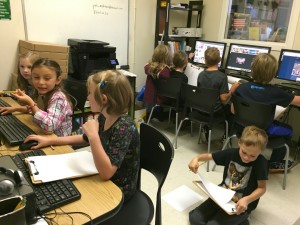 Social Studies with Ms. Laura: We learned about Diwali, the Festival of Lights, with its many traditions. We heard the story of Prince Siddhartha, who grew up and became Buddha. We explored images of Buddha on the internet and drew our own images.
Social Studies with Ms. Laura: We learned about Diwali, the Festival of Lights, with its many traditions. We heard the story of Prince Siddhartha, who grew up and became Buddha. We explored images of Buddha on the internet and drew our own images.
Science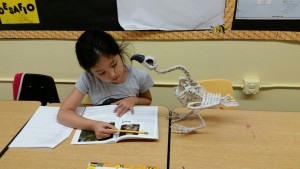
This week in our Animal Classification domain we learned about bird’s wings and feathers. We examine feathers from several different types of birds and we looked at Edgar to examine a bird’s skeleton. We continued our science experiment and looked at pollution impact on in amphibians and reptiles after an extended amount of time.
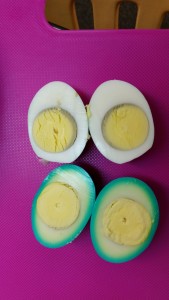
Pollution experiment, day 4
Our objectives this week were to:
• observe and describe basic characteristics of an animal
• identify fish, amphibians, reptiles, and birds as groups of vertebrates
• identify basic characteristics of birds
• classify particular animals as birds
• compare and contrast two groups of vertebrates
English Word Work
We took our spelling test on Thursday. Nice job everyone for being ready to take it a day early! In grammar this week we worked on linking verbs.
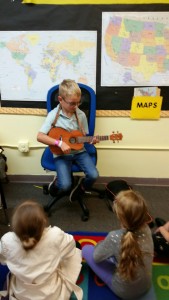
Sharing vacation time
by Sarah Segall | Oct 14, 2017 | In The Loop
Literatura
This week we read Se dice due res goloso and La gata Maroma. Both these poems were great examples of rhyme. Our weekly objectives were:
- listen and respond to the poems
- substitute target sounds to create new words
- practice the skill of visualizing (imagine or picture what is happening in a story)
- identify rhyming words and clap the rhythm of each word
- identify repeated words
- identify and segment final consonant sounds (important in reading and writing!)
- introduction to the writing process: plan. We’ve made lists and now we made a plan for writing about ourselves.
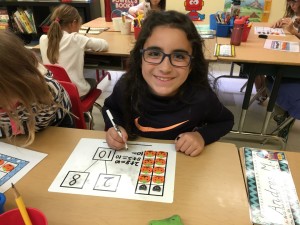 Matemáticas
Matemáticas
This week in math we jumped into subtraction and we had a blast with our halloween themed tens frames and number families. We are working on using our number bonds to help us create number families. The kiddos had a great time crafting their own haunted house for their number families. These are on display in the hallway. Please note the kiddos did a fantastic job following directions on this task. They had to glue on the sides of all windows and place them just right in order to fit correctly on the houses. Many times, crafts are about the academic piece AND following directions! Our learning objectives were:
- to explore different ways to subtract: quitar, restar (by crossing out pictures), menos (-), enunciado de resta (5-3=2), menos que (3 is less than 5)
- to show subtraction with concrete objects like cubes and our number boxes
- counting backwards with and without the number line (the opposite of counting on with addition)
History & Geography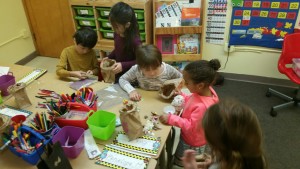
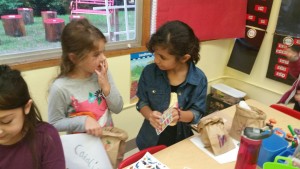
Trading at Market
We finished our unit on Mesopotamia this week. We reviewed what weve learned so far about Mesopotamia and what it takes to make up a civilization. On Thursday the class had a great time with Market Day, trading goods and sampling some Mesopotamian type foods.
Our objectives this week were to
• locate the area known as Mesopotamia on a world map or globe, and identify it as part of Asia
• identify farming, cities, religion, leaders and writing as key factors to the development of a civilization.
• identify Mesopotamia as the cradle of civilization
• review the importance of the Tigris and the Euphrates rivers to Mesopotamia
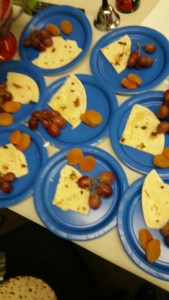
Mesopotamian food at Market
Science
This week in our Animals and Their Habitats domain we read about the temperate deciduous forest and the animals that live there. We’ve compared deciduous trees to evergreens in our own schools back yard. We also looked for Animals near our school that might be found in a
forest.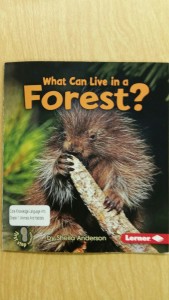
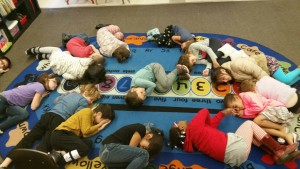
“Hibernation“
Our objectives this week were to:
• understand that living things live in habitats to which they are particularly suited
• understand that living things live in habitats to which they are particularly suited
• identify the characteristics of the temperate deciduous forest habitat
• explain how temperate deciduous forest animals have adapted to the temperate deciduous forest habitat
• classify animals on the basis of the types of food that they eat (herbivore, carnivore, omnivore)
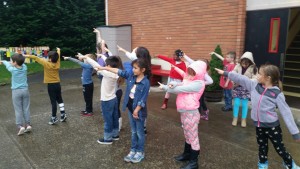
Spotting deciduous tree
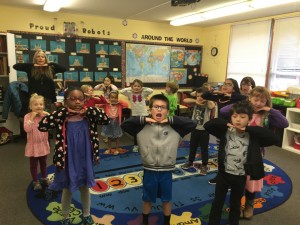
Zoophonics: Lizzy Lizard
English Word Work
in spelling the Red group worked on j and k sounds, the Blue group had the et and en family words, and the Green group had the word families ill, ell, and all. In our journals we wrote about what makes Mesopotamia a civilization. Our word wall words this week were: may, me, my, no, now, not, or, of, off, on. Our vocabulary words this week were: species, temperate, and hibernate.
by Ivary & Paola | Oct 7, 2017 | In The Loop
Literatura
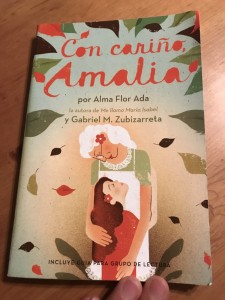 This week we started our anticipated Reading Club, Con carino, Amalia. Students were given a rubric stating the expectations for this project and a reading calendar that will help them stay on track with the reading requirements. Most of the work will be done in class, however students are expected to take the book and the reading log home, so they can re-read parts to clarify understanding and elaborate on their notes and observations. (Students are more than welcome to include this reading in their nightly 15 minutes of Spanish) The reading logs will serve as a foundation for their final assignment. Please make sure you sit down with your child to understand and help facilitate this project. As a culminating activity, students are ask to create an art piece that represents the theme of the book. This part has to be done at home and brought to school as a surprise on our last day, October 27th. We gave some suggestions in class, but they are encouraged to get as creative as they want, through any art medium. If you have any questions, do not hesitate in contacting me.
This week we started our anticipated Reading Club, Con carino, Amalia. Students were given a rubric stating the expectations for this project and a reading calendar that will help them stay on track with the reading requirements. Most of the work will be done in class, however students are expected to take the book and the reading log home, so they can re-read parts to clarify understanding and elaborate on their notes and observations. (Students are more than welcome to include this reading in their nightly 15 minutes of Spanish) The reading logs will serve as a foundation for their final assignment. Please make sure you sit down with your child to understand and help facilitate this project. As a culminating activity, students are ask to create an art piece that represents the theme of the book. This part has to be done at home and brought to school as a surprise on our last day, October 27th. We gave some suggestions in class, but they are encouraged to get as creative as they want, through any art medium. If you have any questions, do not hesitate in contacting me.
Other objectives for this week:
- Explain the characteristics of a realistic fiction piece.
- Write a summary of a story incorporating main idea and supporting details.
- Compare and contrast two realistic fiction pieces.
- Make inferences and ask questions to check for comprehension.
- Understand the structure of simple sentences and identify subject and object (sujeto y predicado)
- Spell palabras esdrujulas and use them in sentences accurately.
- Identify common prefixes in Spanish.
- State an opinion about a subject(orally).
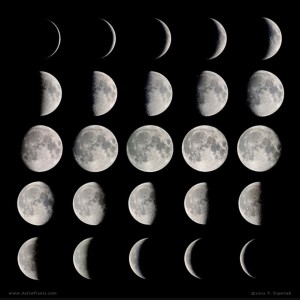 Ciencias
Ciencias
This week we were very excited to start Investigation 2, Planetary Systems. The focus question for the first part of this investigation was: How can you explain why we see some natural objects only in the night sky, some only in the day sky, and some at both times? We began our Night-Sky Observations. Students took a mini–field trip to the schoolyard to look for the Moon. We could not find it and constructed explanations for this phenomenon. Sometimes we can see the moon during the day and sometimes we can’t. After learning vocabulary related to this part (moon phases) and recording the Moon’s appearance, the class started a Moon calendar, on which they will record the Moon’s appearance every day for a month (let’s hope the sky is clear!). Students were assigned to observe the night sky for 4 days at home. We will share our observations on Monday! Some of the science practices included:
- Planning and carrying out investigations.
- Analyzing and interpreting data.
- Obtaining, evaluating, and communicating information.
History & Geography
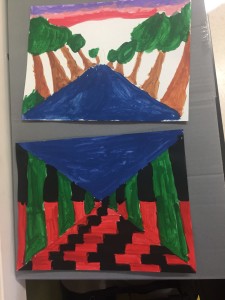 This week we began The Renaissance. Our objectives were:
This week we began The Renaissance. Our objectives were:
- Familiarize students with European Geography and geography from Renaissance Italy
- Identify the Renaissance and when and where it occurred.
- Recognize the connection between the Renaissance and ancient times
- Recognize Italy’s importance to the Renaissancance
- Understand Florentine society of the 1400s.
- Understand and paint a perspective piece
Mathematics
This week we worked with Dividing by tens, hundreds, and thousands. We also divided by 2-digit numbers. Our objectives were:
- Divide numbers up to 4 digits by multiples of 10, 100, or 1,000
- Use Rounding and related multiplication facts to estimate quotients
- divide a by a 2-digit number
English Word Work
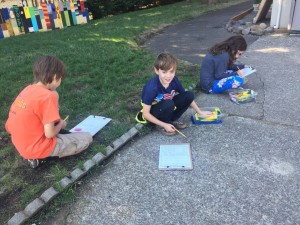 This week began our new rotation. Our rotation days were:
This week began our new rotation. Our rotation days were:
- Word search: students received a word search with their new words and were tasks with finding then sorting them
- Teacher Meeting: I met with each student to check if they understood their new sort
- Vocabulary: We dug through our reading books for words to add to our word wall. The words we found were disconsolate and cygnets
- Spelling City: Students had a chance to get on the computers and practice their computer skills and spelling
Our spelling test will be on Tuesday!
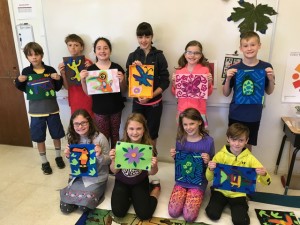 Specialists
Specialists
ART The 4th and 5th grade students finished their felt fabric Mola designs this week in art. These are designs based on the Kuna Indian fabric art of Panama. Here is a photo of the students with their artwork, but you really have to see these designs in person to appreciate how much time and creativity went into these! (Jack was absent but we’ll get a photo of him next week). I will see if there’s a safe spot to display this beautiful art in their classroom. Thank you to Tamra’s mom Barbara for helping everyone with this project!
by Jill & Sarah | Oct 7, 2017 | In The Loop
Literatura
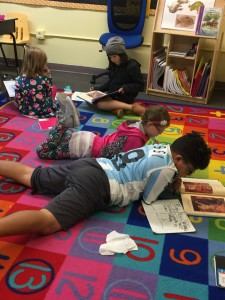
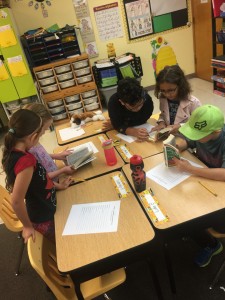 This week we read Rugby and Rosy. Our objectives were:
This week we read Rugby and Rosy. Our objectives were:
- understand what auxiliary verbs are
- use comprehension strategies such as making connections, visualizing, and Self-questions to construct meaning from the story during our first read
- use comprehension skill cause and effect as we read the story the second time
Matemáticas
This week we finished our second chapter and started chapter 3 Addition up to 10,000. Our objectives:
- Add greater numbers without regrouping
- Add greater numbers with regrouping hundreds
History & Geography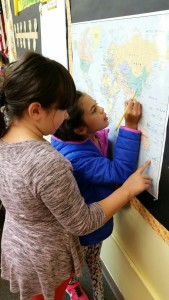
Social studies with Ms. Marci.
This week we in our World Rivers unit we talked about how wildlife is supported on rivers and how rapids and waterfalls affect river travel. We also began a gathering information on all the rivers that we have learned about in this unit in preparation for our unit test next week.
Our objectives were to:
• explain how rivers provide good habitats for wildlife
• refer to a map and describe locations and major features of the Amazon, Orinoco, Mackenzie Rivers, Iguaçu, Paraná, Congo, and Yukon Rivers.
• explain how waterfalls make River navigation difficult
• describe ways that boats can travel on rivers with waterfalls
• understand the meaning of the following domain-specific vocabulary: piranha, humid, waterfall, Arctic Ocean, Northern Hemisphere, migrate, landlocked and rapids
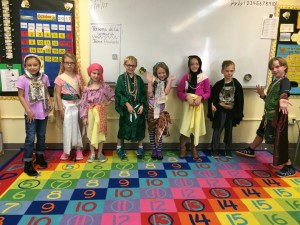 Social Studies with Ms. Laura:
Social Studies with Ms. Laura:
We began our study of Ancient India by learning about the Indus River valley and the people who lived there. We made jewelry and dressed up! We were introduced to Hinduism, learning about its origins and some of its gods. We even practiced some yoga.
Science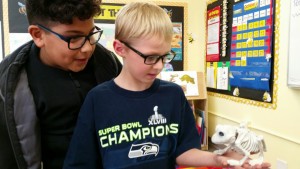
This week in our Animal Classification domain we learned more about the group of amphibians and read up on reptiles, on Friday we began an interesting experiment comparing the skin of amphibians to that of reptiles.
Our objectives this week were to:
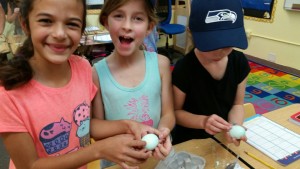
Amphibians and Reptiles
pollution experiment
• identify characteristics of amphibians
• compare and contrast fish and amphibians
• identify basic characteristics of reptiles
• classify particular animals as reptiles
• compare and contrast two groups of vertebrates
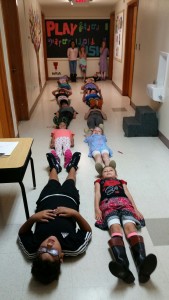
How long are anacondas?
English Word Work
We took our spelling test on Friday. Everyone is working hard and the test reflect this! In grammar this week we worked on auxiliary verbs/ helping verbs.
by Sarah Segall | Oct 7, 2017 | In The Loop
Literatura
This week our Language Arts objectives were:
- to recognize words that rhyme
- identify words in the selection with our letters of the week: ll, m, n, ñ
- discuss how words and pictures go together
- clap rhythms
- put pictures in order of occurrence using: primer, después, luego, finalmente
Matemáticas
This week we worked on ways to add. Our objectives were:
- count on to add.
- use number bonds to add in any order.
- write and solve addition sentences.
- recognize and use the following math vocabulary: summer, más, igual a, enunciado de suma, más que
- K: use dice to work on number identification
History & Geography
In social studies this week we continued our unit on Mesopotamia. On Monday the class had fun making clay tablets and practicing their cuneiform writing. We continue to add information to our civilization chart. On Thursday each student made their own version of a ziggurat (pyramid structure with a temple at the top).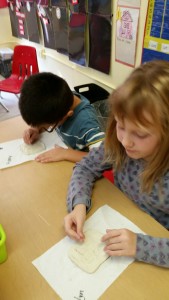
Our objectives this week were to
• locate the area known as Mesopotamia on a world map or globe, and identify it as part of Asia
• describe the significance ofgods/ goddesses, ziggurats, temples, and priests in Mesopotamia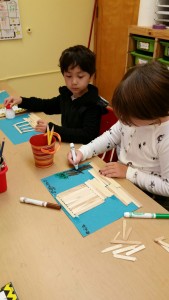
• describe the city of Babylon and the Hanging Gardens
• recall the importance of the Tigres and the Euphrates rivers and canals to support farming and the development of the city of Babylon
• describe the significance of leaders to the development of civilization
• identify Mesopotamia as the cradle of civilization
Science
This week we continued our chapter on East African Savannah and its animals. Tuesday we played a food chain game. Students had to think about what happens when an animal is removed from the chain. On Friday we began our next chapter on the temperate deciduous forest.
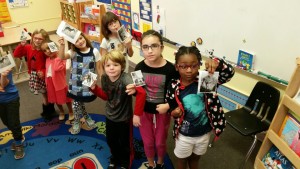
Food Chain game
Our objectives this week were to:
• understand that living things live in habitats to which they are particularly suited
• identify the characteristics of the grassland Habitat
• explain how grassland animal have adopted to the grassland Habitat
• match pacific specific plants and animals to their habitats
• catagorize animals on the bases of the types of food that they eat
• identify the characteristics of the temperate deciduous forest.
English Word Work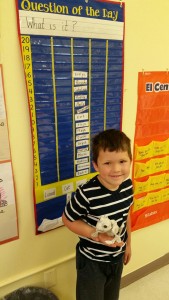
This week in spelling the red group worked on g and h sounds, the blue group had the op,og and ot family words, and the green group worked on in, en, and un words. In our journals this week we wrote about our ziggurat and food chains. Our word wall words this week were: his, has, him, her, for, if, go, do, did
Our vocabulary words this week were:
Cuneiform, climate, food chain, caravan, ziggurat.
by Ivary & Paola | Sep 30, 2017 | In The Loop
Literatura
We read another moving story this week during literature studies. Nuestra cancion is a realistic fiction piece that narrates the story of a girl, her great great grandma and their cultural heritage. After previewing vocabulary and idiomatic expressions, we enjoyed listening to the story, making connections, inferences and stopping at different times to check for understanding. Finally, students were asked to summarize the piece and share their thoughts about the theme. Other literacy objectives for this week included:
- Understand the characteristics of realistic fiction.
- Apply the following comprehension and thinking strategies when reading a piece, predicting, clarifying, asking questions.
- Understand common and proper nouns.
- Explain what a sentence is. Write sentences with appropriate structure and spelling.
Super Readers!
Our fourth/fifth grade class is looking for super readers in Spanish! Students were presented with a reading challenge were they are encouraged to read 11 different books in Spanish. They got to choose their books from “Our Favorite Books in Spanish Basket”. Students estimated how long it will take them to read a book. We set up a date to conference and to report back to maestra Paola. Students may then be ready to choose the next title, or get a book extension. I am looking forward to seeing their reading progress in the coming month.
Reading at Home Reminder
Students are doing a great job reading a minimum of 15 minutes in English and 15 minutes in Spanish every day. This week we were able to accumulate 965 reading minutes in Spanish only! We still have a few students that need to remember to log their minutes on their planners. The minutes only count if they have a parent signature. Maestra Paola checks planners and signatures daily.
Ciencias
Sun Tracking
Groups of students constructed Sun trackers. After using a compass to orient the Sun tracker north-south, students made hourly records of the position of the tip of the shadow cast by a golf tee. Back in the classroom, students used flashlights to reproduce the movement of the Sun throughout the day. This activity also provided us with opportunities to collect and interpret data. At the end of the week students accessed our online resources to read a piece related to this activity. Student have user names and passwords to access these resources from home. This is extra material in Spanish that your child is welcome to use at home.
History & Geography
This week we finished our unit on the Maya, Aztec, and Incas. Our objectives were:
- Identify the Inca and describe where they lived.
- Describe the Sapa Inca and how he maintained absolute rule.
- Explain how the Inca organized their empire and met the needs of the people.
- Compare and contrast the Inca and Aztec civilizations.
- Explain how Inca engineers overcame challenges presented by the geography of the land.
- Describe how the Inca kept their empire together without a written language.
- Understand how the Sapa Inca united his empire.
- Describe the Aztec and Inca reactions to the Spanish conquistadors’ arrival in Mexico and South America.
- Identify Hernán Cortés and Francisco Pizarro as Spanish conquistadors who led invasions in Mexico and South America.
- Explain why the Spanish were rapidly able to conquer the Aztec and Inca Empires.
Students took their unit test on Friday and will receive their scores on Monday!
Mathematics
This week we worked with multiplying numbers by 10s, 100s, and 1,000s. We also worked with multiplying by 2-digit numbers and began dividing by 10s, 100s, and 1,000s. Our objectives were:
- Use rounding to estimate products
- Multiply a 2-, 3-, or 4- digit number by a 2-digit number
- Divide numbers by 10, 100, or 1,000 using patterns
English Word Work
This week we finished our rotation. Our rotation days were:
- Vocabulary: Students dug through our atlases to find words to add to our word wall. The words we found were
- Spelling City: Students had a chance to work on computer skills as well as spelling on spellingcity.com
- Writing Workshop: Students were able to share the writing they have done the last few weeks with the class.
- Blind Sort Test: Students tested each other on their spelling using the Blind Sort method.
Specialists
Character Education: Since the “favorite thing” activity took a bit more time than anticipated, we have barely begun our book The Next Seat. We have started assembling our Literature Circle folders, where students will have different jobs each week as we read the book together as a class. There are some new jobs this year such as Psychologist (where they have to give advice to a character) and Journalist (where they have to write from a character’s perspective). We will continue to have the traditional jobs of Discussion Director (coming up with discussion provoking questions for the group), Passage Picker (picking out passages that caught your attention), Creative Connector (connecting the book to life, movies, self, other books, etc) and much more! We will also be reading the poem Something Called the Wild Geese by Rachel Lyman Field.
October Music with Ms. Erin
In September the Fourth and Fifth Grade class learned about and practiced melody and harmony through songs and singing exercises, learned notes C and D on the recorder (and reviewed notes G, A, and B), learned the Fermata symbol, talked about the periods of classical music and composers who belong to each period, learned about the piano and how to play the C Major Scale (and those who play shared songs with the class), wrote out and clapped rhythms, and worked on the following songs:
– Do, Re, Mi
– Edelweiss
– Blow the Man Down
– The Marine’s Hymn
For October we will be focusing on:
– Continuing work on harmony with both voice and recorders
– Reviewing eighth notes and learning sixteenth notes
– Learn time signature 6/8, practice with clapping and drumming
– Learn to sing a Canon with the song Dona Nobis Pacem
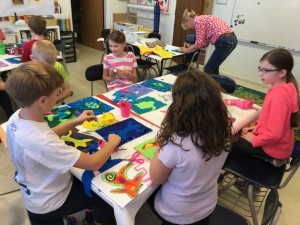 Art:
Art: In addition to their beautiful
sunflower paintings that have been on the bulletin board at school, the 4th and 5th graders have been working on a
Felt Mola Design during September. The students learned that the
Kuna Indians on the San Blas Islands of Panama are known for their fabric Mola designs. These designs originated many years ago from body paint patterns that the Kuna culture used. Today Molas are made by a reverse appliqué technique where layers of fabric are cut into intricate designs. The students started their project with a
colored marker drawing of an animal or plant, and then used felt fabric to cut out the shapes. We are also using the leftover
negative shapes to create a second design.These are turning out quite beautiful. Great job everyone!
by Jill & Sarah | Sep 30, 2017 | In The Loop
Literatura
This week we read La casa del árbol. Our objectives were:
- understand what verbs are
- use comprehension strategies such as making connections, visualizing, and self-questioning to construct meaning from the story during our first read
- use comprehension skill compare and contrast as we read the story the second time
Matemáticas
This week we continued working with mental math and estimation. Our objectives were:
- Use different strategies to add 2-digit numbers close to 100 mentally
- Round numbers to estimate sums and difference
- Use front-end estimation to estimate sums and differences
History & Geography
Social studies with Ms. Marci
This week we in our World Rivers unit we considered a river viewed from above and dangers and navigation of rivers. Some of our big questions were the difference between the source and the mouth of a river, as well as what dangers boats face on rivers. Together as a group we began filling in a chart on interesting facts about World Rivers.
Our objectives were to:
• describe the mouth and the source of a river
• refer to a map and identify the location of the Murray River
• list at least two ways people use the Murray River
• describe the dangers on the Mississippi River and the Ob River
• locate the Mississippi River and the Ob River on a map
• understand the meaning of the following vocabulary and phrase: drainage basin, orchard, vineyard, pasture, sandbar, current, tributary, swamp, wasteland, and “river pilot”
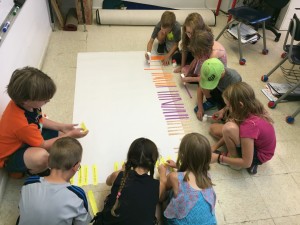 Social studies with Ms. Laura
Social studies with Ms. Laura
This week we completed our study of The Geography Of The Americas by learning about the seven more countries in South America. We reviewed our unit by talking about North America, Central America, The West Indies and South America. We had our assessment and worked together on a project about elevation, plotting the heights of cities close by, capitals of many of the countries studied in this unit and three mountain ranges: The Appalachians, The Rockies and The Andes. We enjoyed an ‘end of unit’ celebration!
Science
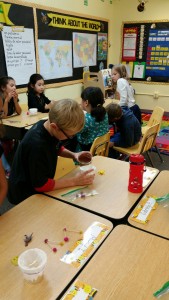
Demonstrating how gills work for fish.
This week in our Animal Classification domain we learned about two groups of animals, amphibians and fish. Students worked on different classification charts in order to better understand how each group of animals has unique characteristics. We also finished our animal shape poems. 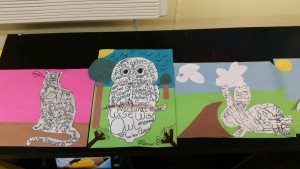
Our objectives this week were to:
• explain that scientists classify animals in order to study them and show relationships
• identify basic characteristics of fish and amphibians
• classify particular animals as fish
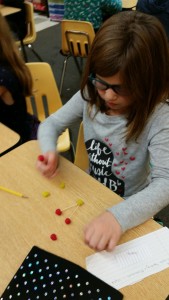
H2O molecule model
• classify particular animals as amphibians
• compare and contrast two groups of vertebrates
English Word Work
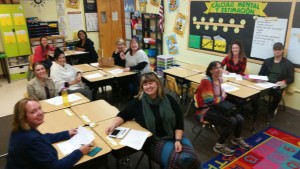
Thanks for attending curriculum night everyone!
We took our spelling test on Friday. Everyone did great! We had quite a few perfect scores. A couple of students wrote stories with their spelling sorts for homework this week, I was quite impressed with the creativity these spelling words could inspire! In grammar we worked on verbs; present, past, future tense. On Mondays the class will have the opportunity to go to our school library. They do not have to check out a new book each week. I’m encouraging students to check out chapter books that they can take home and read for a while. I’m reminding Students to try to find a special place to put their book in order to keep track of them over the weeks that they have the book checked out.
Specialists
Character Education: I so enjoyed having the students bring in one of their “favorite things” over the past few weeks! It’s such a fun “get to know you” activity. This took a bit more time than anticipated, so we are finishing up our theme on Manners next week and then will move on to our next theme: Friendship, Cooperation, and Teamwork. In K-3rd grades, we will be reading some great books including The Name Jar by Yangsook Choi, and Amos and Boris by William Steig. Our poem will be a seasonal one, called Something Called the Wild Geese by Rachel Lyman Field. Be sure to check the bulletin board to see more books, as well as the poem, song, and quote we’ll focus on for the next several weeks.
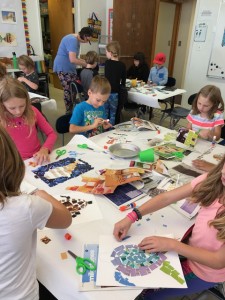 Art: The 2nd and 3rd graders started the school year with some fabulous sunflower paintings which we’ve all enjoyed on the bulletin board!
Art: The 2nd and 3rd graders started the school year with some fabulous sunflower paintings which we’ve all enjoyed on the bulletin board!
Next we learned about Ancient Roman mosaics, which are pictures made of glass or stone tesserae (tiles). The students learned that mosaics were most often used on floors and walls of ancient Roman buildings and homes.
After choosing a simple animal shape (fish, turtle, lizard), the students used magazine pages to cut out paper “tiles” to fill in the shapes. Then they made a background of somewhat contrasting colors. Lastly, they made a mosaic border. Some of these mosaic animals are camouflaged in their settings, but they’re all very creative! Check them out on the bulletin board at school!
We also had time to start on an Australian Aboriginal Dot painting, using q-tips as our painting tools. The students are using the same animal shape as their mosaic, so we will be able to compare and contrast these different art techniques.
October Music with Ms. Erin
In September the Second and Third Grade class learned about Quarter, Half, and Whole notes, the American composer John Philip Sousa, Marches and how to march to a beat, 4/4 time signature, played fast and slow rhythms on the drums, learned the meaning of verse and refrain, sang Solfeggio, played the C Major scale on the electric piano, and sang the following songs:
– I’ve Been Working on the Railroad
– Li’l Liza Jane
– Clementine
– Good Bye Old Paint
– Alouette
For October we will be focusing on:
– Reading treble clef notation
– Time signatures 3/4 and 2/4
– Clapping, drumming, and reading eighth notes
– Singing a ’round’
– Recognizing brass instruments in a symphony orchestra by listening to Rossini’s ‘William Tell Overture’ and Mozart’s Horn Concertos
by Sarah Segall | Sep 30, 2017 | In The Loop
Literatura
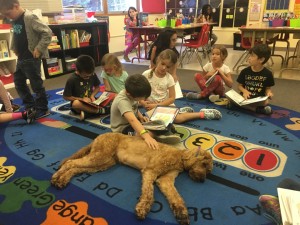
reading with Lily
This week we read, sang, and acted out Canción del bichito de luz and Los 3 Perritos. Our learning objectives this week were to:
- read, trace, write and use our sight words in sentences: may, el, bebé, yo.
- correctly form our daily letters in upper and lower case: Ii, Jj, Kk, Ll.
- identify beginning sand endings of words and spaces between words.
- identify rhyme within a poem.
- create rhymes with their own names.
- segment syllables, identify the initial and final sound in given words.
- use capital letters for names of people, states, and cities.
First graders are meeting with me multiple times a week in reading groups. They should practice reading their books on a daily basis. They each have an incentive chart and can mark their chart for each book they read. They will go to the treasure box each time they fill their incentive chart.
Kindergarteners will be receiving their readers in a few weeks and will have the opportunity to fill out their own incentive charts for trips to the treasure box.
Matemáticas
Our math objectives for this week were to:
- create number bonds
- identify missing numbers from number bonds
- use a number balance to check our number bonds
- add within 0-10
- write our numbers correctly
History & Geography
This week we wrapped up our landform unit by playing a landform riddle game and acting out different landforms. On Tuesday we begin a new unit on Early World Civilizations. We’ve started off with Mesopotamia as our first civilization to study.
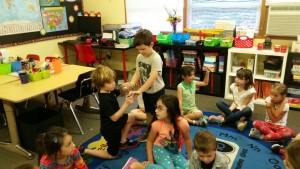
Land form acting
Our objectives this week were to
• Identify and locate the Middle East on a map of Asia.
• find the area known as Mesopotamia on the map and understand that this was part of Asia
• explain the importance of the Tigris and Euphrates rivers, and the use of canals, to support farming
• describe the city of Babylon
• identify cuneiform as a way of writing in Mesopotamia
• explain why writing is important to a civilization
Science 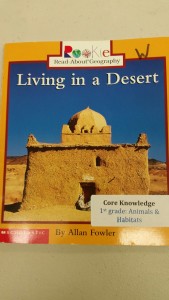
This week we took a pause and reviewed what we’ve learned so far about the three habitats that we had studied. At the end of the week we began our next unit on the East African Savanna. We watched a short video on animals from this region.
Our objectives this week were to:
• describe the three things that a habitat must have
• review what we have learned about the Arctic Ocean, Arctic Tundra, and the Sonoran Desert
• review what it means to classify animals as herbivore, carnivore, omnivore
• identify the characteristics of the grassland habitat, specifically the East African Savanna
• identify four geographical regions of Africa on a map
English Word Work 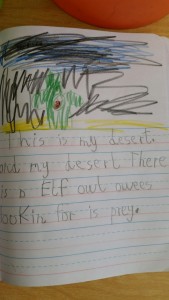
This week in spelling the blue group worked on d and f sounds, the blue group had the ap and ad family words, and the green group worked on ad, ab, ed, ob words. In our journals we wrote and drew things about our desert . Our word wall words this week were: what, this, here, there, where, why, who, how
Our vocabulary words this week were: desert, canals, trade, Savanna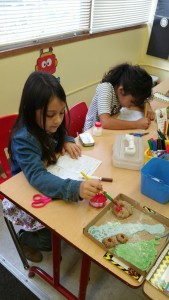
Specialists
Character Education: I so enjoyed having the students bring in one of their “favorite things” over the past few weeks! It’s such a fun “get to know you” activity. This took a bit more time than anticipated, so we are finishing up our theme on Manners next week and then will move on to our next theme: Friendship, Cooperation, and Teamwork. In K-3rd grades, we will be reading some great books including The Name Jar by Yangsook Choi, and Amos and Boris by William Steig. Our poem will be a seasonal one, called Something Called the Wild Geese by Rachel Lyman Field. Be sure to check the bulletin board to see more books, as well as the poem, song, and quote we’ll focus on for the next several weeks.
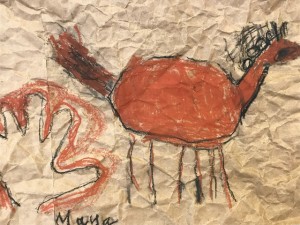 Art:
Art:
We jumped right in with art history this month, and the students learned about ancient Cave Paintings and also ancient Egyptian art.
We made our own textured “rock” surfaces by crumpling paper grocery bags, and the students learned how to use basic shapes to draw either a deer or a horse. The students used oil pastels similar in color to the red ochre rocks that prehistoric people used to make crayons and paint. The students “signed” their paintings with hand prints like the ones found in several cave paintings.
We looked at some famous Egyptian art and jewelry, and learned that the Egyptians used carvings of Dung Beetles in much of their art work. Egyptians revered the dung beetle (a type of Scarab Beetle) which makes balls of dung as a nest and food source for their eggs!
The students learned how to use basic shapes to draw a beetle, and then they used watercolors to mix yellow and blue to paint their beetle green.
All the kiddos did a great job this month, and we will start some Fall Leaf projects in October.
October Music with Ms. Erin
In September the Kindergarten and First Grade class learned about Quarter, Half, and Whole notes, dynamic signs for loud and quiet, high and low sounds, clapping and counting a steady beat, and got to play my electric piano.
We also sang songs together, including:
– Twinkle, Twinkle, Little Star
– Old MacDonald
– London Bridge
– Farmer in the Dell
– Go Tell Aunt Rhody
– Kumbaya
– On Top of Old Smoky (and the funny version, On Top of Spaghetti!)
For October we will be focusing on:
– Learning about composers (story time: famous composer Wolfgang Amadeus Mozart)
– Listening to Edvard Grieg’s works ‘Morning’ and ‘In the Hall of the Mountain King’
– Hearing and moving to differences in musical phrases and styles (repeated melodies vs changing melodies, bouncy and smooth, fast and slow, etc.)
And of course, we will sing more songs together!
by Ivary & Paola | Sep 23, 2017 | In The Loop
Literatura
This week we dove into our first literacy unit, Cultural Heritage. Some of the guiding questions included: What does heritage mean? How can someone know about their heritage? What are some ways heritage can be transmitted and maintained? Students constructed insightful explanations and made meaningful connections according to their own personal experiences. Please take some time this week to tell your child stories about your family’s heritage. I was very happy to share a little about my own heritage and cultural traditions as we celebrated Chilean Independence Day on September 18th. After that, we read our first story, La tierra que perdi, aventuras de un nino en Vietnam. Please ask your child to tell you about this wonderful autobiography. After reading the story, we discussed the theme. We also analyzed the author’s point of view and the characteristic of an autobiography. Lastly, we had the oportunity to talk about language as cultural heritage and looked at the roots of words and their meaning. All in all, it was a wonderful way to start our unit!
Other objectives in Literacy this week included:
- Reflect on strengths and areas to work on. Identify and establish individual goals
- Understand and explain the concept of heritage
- Explain the characteristics of an autobiography
- Identify the author’s point of view and provide some examples
- Apply the comprehension strategies when reading the selection
On Friday we had our first spelling quiz. Students received their new spelling list and are required to turn in 10 sentences on Monday, using these words in context and applying the language structures discussed in class.
Ciencias
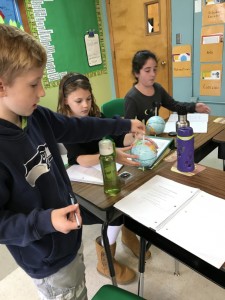 Guiding question: What causes day and night?
Guiding question: What causes day and night?
During the part 3 of our first investigation we did a little simulation. Students imagined themselves as observers on Earth and positioned themselves around a lamp to observe day and night. They discussed that rotation of Earth results in day and night and, in the process, figured out which direction Earth rotates on its axis. Students have a solid understanding of objectives for this part of the investigation:
- Day is the half Earth surface being illuminated by sunlight; night is the half of Earth’s surface in its own shadow.
- The cyclical change between day and night is the result of Earth’s rotating on its own axis in associations with the stationary sun.
Students encountered a fun challenging question too: If a planet did not rotate, would it have day and night? What do you think? Share your thought with your child.
It was very interesting to explore some science tools. This week we talked about the compass. Also, Mr. Wegner was very generous to let us borrow his telescope. We will be exploring this amazing resource next week!
History & Geography
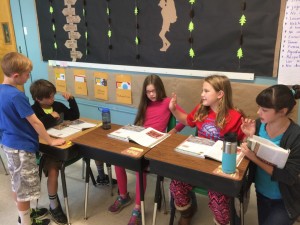
This week we began our unit on The Maya, Aztec, and Inca. Our objectives were:
Discussing the Incas!
- Review geography of the Americas, The Maya, The Aztec, and The Inca civilization
- Identify the Maya as one of the earliest civilizations in the Americas, located in parts of Mexico and Central America.
- Explain how religious beliefs led to the Maya’s scientific achievements.
- Explain how the Aztec built and controlled a powerful empire.
- Describe Aztec religious beliefs and how they were linked to the traditions of the society.
- Identify Moctezuma II and describe features of his reign.
- Identify the Inca and describe where they lived.
- Describe the Sapa Inca and how he maintained absolute rule.
Mathematics
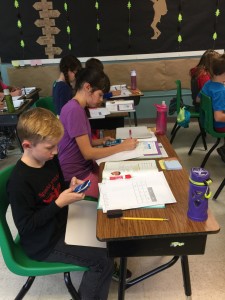
This week we took our unit test on Whole Numbers. We also began our new unit Whole Number Multiplication and Division. Our objectives were:
Learning how to use our calculators!
- Use a calculator to add, subtract, multiply, and divide whole numbers
- Multiply numbers by 10, 100, or 1,000 using patterns
English Word Work
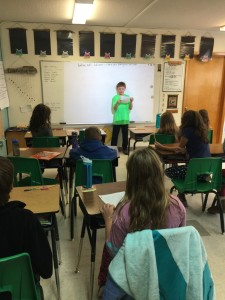
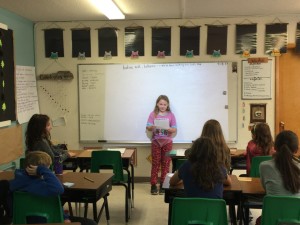 This week finished our rotation and started again from the beginning. Our rotation days were:
This week finished our rotation and started again from the beginning. Our rotation days were:
- Writing workshop: Students were able to review the writing they had done up until this point. They revised and edited their writing individually and with a partner.
- Blind Sort Test: Students tested each other on spelling using the Blind Sort method.
- Word Search: Students received a word search with their new spelling words. They were tasked with finding and sorting their new words.
- Teacher Meeting: I met with each student to discuss and clarify their new sort.
Our spelling test will be on Friday!

 Social Studies with Ms. Laura: We learned about Diwali, the Festival of Lights, with its many traditions. We heard the story of Prince Siddhartha, who grew up and became Buddha. We explored images of Buddha on the internet and drew our own images.
Social Studies with Ms. Laura: We learned about Diwali, the Festival of Lights, with its many traditions. We heard the story of Prince Siddhartha, who grew up and became Buddha. We explored images of Buddha on the internet and drew our own images.












































